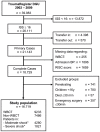Whole-body CT in haemodynamically unstable severely injured patients--a retrospective, multicentre study
- PMID: 23894365
- PMCID: PMC3722202
- DOI: 10.1371/journal.pone.0068880
Whole-body CT in haemodynamically unstable severely injured patients--a retrospective, multicentre study
Abstract
Background: The current common and dogmatic opinion is that whole-body computed tomography (WBCT) should not be performed in major trauma patients in shock. We aimed to assess whether WBCT during trauma-room treatment has any effect on the mortality of severely injured patients in shock.
Methods: In a retrospective multicenter cohort study involving 16719 adult blunt major trauma patients we compared the survival of patients who were in moderate, severe or no shock (systolic blood pressure 90-110,<90 or >110 mmHg) at hospital admission and who received WBCT during resuscitation to those who did not. Using data derived from the 2002-2009 version of TraumaRegister®, we determined the observed and predicted mortality and calculated the standardized mortality ratio (SMR) as well as logistic regressions.
Findings: 9233 (55.2%) of the 16719 patients received WBCT. The mean injury severity score was 28.8±12.1. The overall mortality rate was 17.4% (SMR = 0.85, 95%CI 0.81-0.89) for patients with WBCT and 21.4% (SMR = 0.98, 95%CI 0.94-1.02) for those without WBCT (p<0.001). 4280 (25.6%) patients were in moderate shock and 1821 (10.9%) in severe shock. The mortality rate for patients in moderate shock with WBCT was 18.1% (SMR 0.85, CI95% 0.78-0.93) compared to 22.6% (SMR 1.03, CI95% 0.94-1.12) to those without WBCT (p<0.001, p = 0.002 for the SMRs). The mortality rate for patients in severe shock with WBCT was 42.1% (SMR 0.99, CI95% 0.92-1.06) compared to 54.9% (SMR 1.10, CI95% 1.02-1.16) to those without WBCT (p<0.001, p = 0.049 for the SMRs). Adjusted logistic regression analyses showed that WBCT is an independent predictor for survival that significantly increases the chance of survival in patients in moderate shock (OR = 0.73; 95%CI 0.60-0.90, p = 0.002) as well as in severe shock (OR = 0.67; 95%CI 0.52-0.88, p = 0.004). The number needed to scan related to survival was 35 for all patients, 26 for those in moderate shock and 20 for those in severe shock.
Conclusions: WBCT during trauma resuscitation significantly increased the survival in haemodynamically stable as well as in haemodynamically unstable major trauma patients. Thus, the application of WBCT in haemodynamically unstable severely injured patients seems to be safe, feasible and justified if performed quickly within a well-structured environment and by a well-organized trauma team.
Conflict of interest statement
Figures


References
-
- CDC (2011) Deaths: Final Data for 2009. Preliminary National Vital Statistics Reports of the CDC. - PubMed
-
- Kochanek KD, Xu J, Murphy SL, Minino AM, Kung H-C (2011) Deaths: Preliminary Data for 2009. National Vital Statistics Reports of the CDC 59: 1–51. - PubMed
-
- Annual Report of the TraumaRegister® of the German Trauma Society (DGU) (2011), Cologne: Committee on Emergency Medicine, Intensive and Trauma Care (Sektion NIS) – German Trauma Society (DGU).
-
- Deunk J, Dekker HM, Brink M, Vugt vR, Edwards MJ, et al. (2007) The Value of Indicated Computed Tomography Scan of the Chest and Abdomen in addition to the Conventional Radiologic Work-up for Blut Trauma Patients. J Trauma 63: 757–763. - PubMed
Publication types
MeSH terms
LinkOut - more resources
Full Text Sources
Other Literature Sources
Medical

